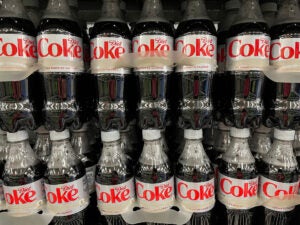The artificial sweetener, aspartame, was recently in the news for being classified as a Group 2B carcinogen by the International Agency for Research on Cancer, the World Health Organization’s cancer research agency.
But what does this really mean? Do you need to give up your diet soda?
The IARC assesses substances and puts them into four different classifications based on how strong the evidence is that a given substance causes cancer in humans. One important thing to understand about these classifications is that they are based on hazard rather than risk. Risk takes dose into account, while hazard does not. The IARC doesn’t assess the level of risk that a particular agent poses with respect to cancer. They simply rank the quality of the evidence of it being cancer-causing.
- Group 1 means there’s sufficient evidence in humans for it to cause cancer. Examples of Group 1 substances include: tobacco smoking, solar radiation, and ethanol in alcoholic beverages.
- Group 2A substances are defined as “probably carcinogenic to humans.” Evidence for the carcinogenic nature of substances in this group in humans is still somewhat limited, but there is sufficient evidence in experimental animals. Examples of Group 2A substances are: red meat, occupational exposure as a hairdresser, and night shift work.
- Group 2B substances are defined as “possibly carcinogenic to humans,” where there is limited or no evidence in humans as well as limited to insufficient evidence in animals. Examples of Group 2B substances in addition to aspartame are: aloe vera whole leaf extract, pickled vegetables (traditional Asian), and gasoline engine exhaust.
- Group 3 substances are defined as “not classifiable as to its carcinogenicity to humans” and include substances such as coffee and fluorescent lighting.
- The IARC monographs were revised in 2019, and Group 4 (“probably not carcinogenic to humans”) was removed. This means that IARC will never conclude that an agent doesn’t pose a carcinogenic hazard — at best, no matter how much data there is to the contrary.
Another thing to note is that the IARC’s index only tells us how strong the evidence is that something causes cancer. Substances in the same category can differ vastly in how much they increase cancer risk.

What it means for aspartame
So, although the IARC has concluded that aspartame is “possibly carcinogenic to humans,” the evidence for this is limited in humans, and it does not take into account the dose that a person can safely consume.
Aspartame is one of the most-studied food additives, so it’s not that there’s a lack of evidence either. There are several large epidemiological studies looking at hundreds of thousands of people that have failed to find a link between aspartame and different types of cancer. This 2012 study, which assessed diet in the Nurses’ Health Study and the Health Professionals Follow-Up Study, included more than 100,000 people and found no association between non-Hodgkin’s lymphoma, myeloma, or leukemia, and diet soda. This 2014 study also looked at more than 100,000 people and found no increased risk of a range of cancers with daily consumption of artificially or sugar-sweetened carbonated beverages.
A 2023 case control study evaluated the association of use of aspartame and other artificial sweeteners with cancer and found no associations between the consumption of aspartame or other artificial sweeteners and cancer. A recent systematic review of several toxicological and epidemiological studies summarized the evidence, finding no consistent evidence of carcinogenicity from epidemiological studies on non-sugar sweeteners use.
Only one single paper found a rather weak correlation between aspartame intake and cancer, not to mention, reverse causality being a potential explanation as well.

So, if the IARC doesn’t take dose into account, who should we be looking to for advice on the amount that we can safely consume?
Well, that would be the World Health Organization and Food and Agriculture Organization’s Joint Expert Committee on Food Additives (JECFA), and they concluded that there was no sufficient reason to change the previously established daily intake of aspartame of 0-40 mg/kg body weight. For example, an adult weighing 70kg would need to consume more than 9 to 14 cans per day of a diet soft drink containing 200 or 300 mg of aspartame per can to exceed the acceptable daily intake, assuming no other intake from other food sources.
Both the IARC and JECFA conducted independent reviews to assess the possible health risks associated with aspartame consumption. This is the first time the IARC has evaluated aspartame and the third time for JECFA.
“JECFA also considered the evidence on cancer risk, in animal and human studies, and concluded that the evidence of an association between aspartame consumption and cancer in humans is not convincing,” said Dr. Moez Sanaa, WHO’s Head of the Standards and Scientific Advice on Food and Nutrition Unit.
It’s really unfortunate that the IARC classification has sparked unnecessary alarm over aspartame and that those findings were released before JECFA could weigh in and reaffirm its safety.
In conclusion, don’t pay attention to the misleading headlines, and if you enjoy aspartame sweetened beverages, the recent IARC classification should not be cause for concern.
Food Science Babe is the pseudonym of an agvocate and writer who focuses specifically on the science behind our food. She has a degree in chemical engineering and has worked in the food industry for more than decade, both in the conventional and in the natural/organic sectors.



